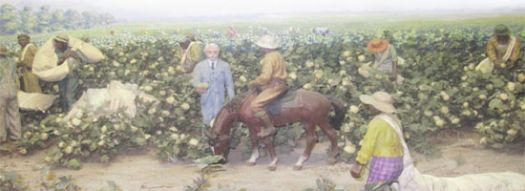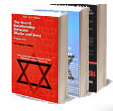
(FinalCall.com) – According to The Secret Relationship Between Blacks and Jews, Volume 2 (TSRV2), Southern Jewish politicians were at the forefront of the disenfranchisement of Blacks. The removal of northern troops from the South after the infamous “1877 Compromise” and the subsequent establishment of Jim Crow Black Codes made it virtually illegal for Blacks to participate in the cotton-based agri-business bonanza generated from the forced labor of the Black ex-slaves. The new system they set up was called “sharecropping.” However, this system was not new to the European Jews that set it up. They had a model from their secretive holy book called the Talmud and it was similar to the Old Testament system that Joseph set up for Pharaoh.
The new sharecropping system went like this: Cotton was the only cash crop that the Jewish merchants would accept as collateral from Black farmers in exchange for the staples he needed from the merchant to feed his family until the crop was harvested six months later. The Black farmers would then have to give that crop back to the merchants who loaned them the money at whatever interest and additional charges that these merchants saw fit, so that by the end of the harvest season the Black farmer wound up owing more money than at the beginning of the season.
One of the Black Codes stated: “Blacks were forbidden to sell farm products like flour, cotton, hay, rice, peas, wheat, etc., without the written permission from a White man.” So with the virtual elimination of the ability of Blacks to benefit from the production of the raw cotton, and then being disallowed from selling other commodities that they could have produced, the Jewish merchants and cotton brokers made profits that would later produce financial giants such as Lehman Brothers and the Seligman enterprises.
The parallels between the Black sharecropping system that developed in Reconstruction America and that which existed in the Jewish society of ancient Babylonia are hard to ignore. It is entirely plausible that their ancient blueprint factored into their economic schemes set up in the South. TSRV2 quotes Jacob Neusner who stated that early sages of Talmudic Jews had developed “rules governing land use, placement of diverse types of crops, rights of ownership, alongside provision of part of the crop to those whom God had designed as recipients of his [sic] share of the produce …God owns the land, the householder is the sharecropper …” (emphasis mine)
In fact, the Bible’s Deuteronomy 23:20 explicitly permits Jews to engage in usury against non-Jews and dictates that land should be used to ensure a usurious loan. So the crop liens and usurious credit arrangements described in TSRV2 that locked Southern Blacks into desperate, generational poverty under the modern Pharaoh were identical in every way to the so-called “hubullum loans” pushed onto the peasant farmers by the moneylenders of ancient Israel.
An example of the Talmudic form of sharecropping can be read in the scriptures of the Bible in relation to Joseph and Pharaoh. “Pharaoh” was not a name but a title, which according to the 1981 World Book Encyclopedia “was a title of the later kings of ancient Egypt. The Egyptians did not call their ruler pharaoh until after they were conquered by foreigners (the Hyksos) around 1700 B.C. Even then, pharaoh was not one of the king’s most important titles.” It was a title used only by foreigners who conquered Egypt until they were kicked out. It is only the writers of the Old Testament who used “Pharaoh” as a title for the king of Egypt.
Now the passages in Genesis (47:20-27) referring to the relationship between Joseph and this “Pharaoh” who enslaved the Egyptian people make sense where Joseph essentially sets up a sharecropping system for Pharaoh. According to the Bible, Joseph gave the Egyptian people and their land to Pharaoh. Joseph then gave the Egyptian farmers seed, rented them back their land and took 20 percent of the crop for Pharaoh.
In the sub-chapter called “The Cost of the Black-Jewish Relationship” in TSRV2, we get the data that allows us to produce a precise analysis of the economic losses of the Black farmers as compared to the economic profits of the merchant class (modern Pharaoh). The merchant’s investment would be what he loaned the Black sharecropper to produce his cotton crop plus whatever overhead expenses he incurred. The expenses for an average-sized 25 acre cotton farm would include rent, mules, farming implements, and ginning fees amounting to about $261 for the farm. According to TSRV2, the total yield for 25 acres of cotton would be 12 bales of cotton paying the farmer $35 per bale or $420 for the whole crop. Now when you subtract expenses of $261 from the gross returns of $420, the farmer is left with $159 as the returns to his and his family’s labor for six months of work on 25 acres. This is $26.50 per month to be split up with the whole family–less than a dollar a day.
merchant class (modern Pharaoh). The merchant’s investment would be what he loaned the Black sharecropper to produce his cotton crop plus whatever overhead expenses he incurred. The expenses for an average-sized 25 acre cotton farm would include rent, mules, farming implements, and ginning fees amounting to about $261 for the farm. According to TSRV2, the total yield for 25 acres of cotton would be 12 bales of cotton paying the farmer $35 per bale or $420 for the whole crop. Now when you subtract expenses of $261 from the gross returns of $420, the farmer is left with $159 as the returns to his and his family’s labor for six months of work on 25 acres. This is $26.50 per month to be split up with the whole family–less than a dollar a day.
On the other hand, the cotton merchant loaned the farmer money to pay his rent ($210), his ginning fees ($51), and gave him consumer items at an over-inflated credit price ($80), for a total of $341. When he sold the farmer’s cotton for $672, he only paid the farmer $420 for those 12 bales. So he made an initial profit of $252 ($672-$420) plus an additional $37 in profits he made off of the farmer’s store purchases. So, with an initial investment of $341, the cotton merchant made a total profit of $289 ($252+$37) for a return on his investment of 84.7 percent or four times the profits of the ancient Pharaoh.
TSRV2 uses H. Hiller who had 400 Black sharecroppers under his control as an example of the profit making potential of these merchants. So if Mr. Hiller had 400 such farmers beneath him, he would have made $115,600 in clear profits per year, while each of his Black farmers at best was living off of $159 per year. This is the real secret relationship between the Black sharecropper and the Jewish cotton merchant after we thought slavery had ended. It was a new slavery which put the “free” Black farmer (the “Real Children of Israel”) under the Jewish cotton merchant–the real modern Pharaoh.
TSRV2 reads like an economic road map. It defines the once hidden milestones and economic turns that allowed the European Jews to come to America broke, but given a knapsack, a few goods and the Black community to exploit. The former slaves were no match for a well-greased, experienced, and integrated machine that this merchant class brought with them from Europe. The once-slave came out to this new world with farming skills, building skills, accustomed to hard work, and with large families to help with the harvest. Cotton and sharecropping broke the spirit of this agrarian class and drove their children to the cities, leaving their land behind to be confiscated by the children of their former slave masters. This cruel plan destroyed the natural inclination of Black people to be industrious and productive members of a communal agrarian village and destroyed the economic fiber of the Black community. As “King Cotton” made Jewish merchants the kings of finance, the sharecropping system of production drained the economic wealth of Black people in America.
The Black farmers who decided to stay and fight against these economic odds bought 16 million acres of farm land by 1910. They struggled and held on to this land until recently tricked by the new moneylenders hiding behind the banner of the U.S. Department of Agriculture. And even after bringing the government to court in 1997 and proving that they were discriminated against by the USDA in terms of financial loans and government subsidies, only 10 percent of the 19,000 Black farmers on the books of the USDA were given any court-ordered relief. The Black farmers were tricked by their Jewish lawyer who worked hand-in-hand with the Jewish federal judge. As we write, the Native Americans and Hispanic Americans are receiving some measure of relief, but the Black farmers have been sent back to Congress to beg for what was stolen from them by the government and families of USDA employees. Even if Black farmers or land owners receive the $1.25 billion promised to them in the most recent judgment, the U.S. government still owes them another $23 billion compensation for the 13 million acres of farmland lost due to the USDA’s relentless schemes to confiscate their property.
The research released by the Hon. Min. Louis Farrakhan has proved that “Pharaoh” is not a 4,000 year old Old Testament concept. Our hard-working and industrious farmers have been victimized by this new Pharaoh’s devious schemes all over the South, and now our eyes are finally coming open. We now see that we are indeed the REAL Children of Israel, but we have been tricked into taking advice, counsel, and “friendship” from the agents of a wicked Pharaoh. And now that The Hon. Min. Louis Farrakhan has revealed their scheming against God’s people, it is time to ACT like the true Children of Israel and move on to OUR OWN Promised Land.
(Dr. Ridgely Abdul Mu’min Muhammad, Agricultural Economist, National Student Minister of Agriculture and Farm Manager of Muhammad Farms. He can be reached at [email protected])












